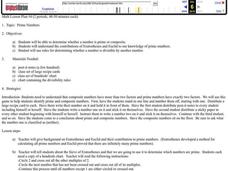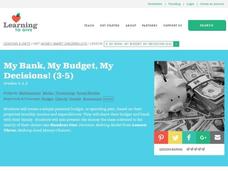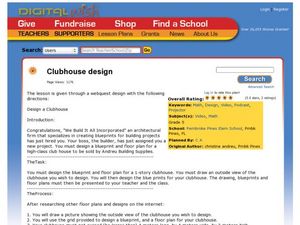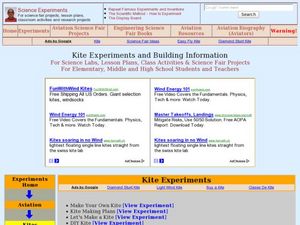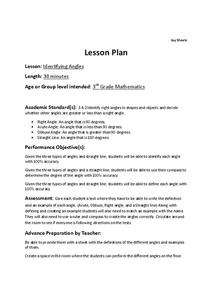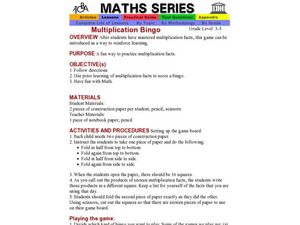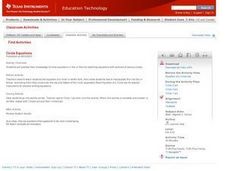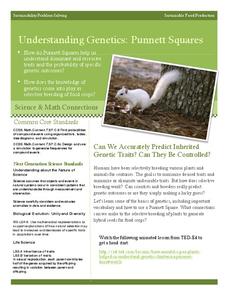Curated OER
Prime Numbers
Students differentiate between prime and composite numbers. In this algebra lesson, students define the terminology and investigate the contributions made by Eratosthenes and Euclid as it relates to prime numbers. Students apply the...
Curated OER
Sunny Sunflowers
First graders, after assessing how plants grow in relation to light, create models of sunflowers within a game to help them remember their science lesson. In addition, their visual models serve as a demonstration of photo tropism in...
Curated OER
My Bank, My Budget, My Decisions!
Students build a budget. In this philanthropy lesson, students write a personal budget that includes spending, saving, investing, and donating. Student philanthropists donate money to charities.
Curated OER
Clubhouse Design
Fifth graders design a blueprint and floor plan for a one-story clubhouse. In this architectural design lesson, 5th graders view several floor plans and blueprints on the Internet then design a one-story clubhouse that includes...
Curated OER
Kite Experiments and Building Information
Students build their own kite following certain procedures. In this physics lesson, students explain the aerodynamics concepts involved in flying kites. They trace the development of aviation.
Curated OER
Identifying Angles
Third graders analyze angles and determine if they are acute, right, or obtuse. In this angles lesson, 3rd graders study the definition and characteristics of each angle. Students then do a worksheet to identify the name of the angle.
Curated OER
Statistics
High schoolers log their computer usage hours. They determine the mean, median, mode and standard deviation of the collected data. They make a frequency histogram of the grouped data, both on graph paper, and on the TI 83+ graphing...
Curated OER
What's The Idea?
Sixth graders explore line segments, rays, parallel, perpendicular and intersecting lines. The teacher discusses, with the class, real life items that represent each geometric idea studied. They use cotton balls, strings and popsicle...
Curated OER
Making 10 to Add 7, 8, and 9
In this math worksheet, students solve addition problems with 7, 8 and 9 by using a ten-frame and counters. Students follow the detailed directions for addition on the page. There are also 5 activities to do with a study buddy.
Texas Instruments
Circle Equations
Students explore the coordinate plane. In this secondary mathematics instructional activity, students follow a set of directions to plot points in the coordinate plane.
Curated OER
More Number Tricks
In this more number tricks worksheet, students study and analyze how to use symbols to set up and solve problems. Students follow twenty directives to solve several word problems.
Curated OER
Converting Metric Units Of Length
In this converting metric units of length worksheet, students convert thirty metric units of length as directed by following the instructions on the worksheet.
Baylor College
About Air
Give your class a colorful and tasty representation of the components of the mixture that we call air. Pop a few batches of popcorn in four different colors, one to represent each gas: nitrogen, oxygen, argon, and carbon dioxide. The...
August House
Anansi Goes to Lunch - Kindergarten
Greed is the theme of the West African folktale, Anansi Goes to Lunch and this multidisciplinary collection of lessons. First, scholars listen to a read aloud and participate in a grand conversation about the book's key details and...
Space Awareness
Navigation in the Ancient Mediterranean and Beyond
Ancient texts, like Homer's Odyssey, mentions navigating ships by observing constellations. Pupils learn about the link between history and astronomy as they relate to navigation in the Bronze Age. Scholars complete two hands-on...
Curated OER
Call to Arms: A Service Project
Sick of selling candy and washing cars? How about hosting a Digital Day or a Learning Lunch? The suggestions here make fund raising fun and rewarding. Raise money to preserve important maps and other primary source documents.
Western Kentucky University
Understanding Genetics: Punnett Squares
Can scientists really predict genetic outcomes or are they simply making a lucky guess? Scholars first learn about Gregor Mendel and how to make Punnett squares. Then they extract DNA from a strawberry in a lab with included conclusion...
National Woman's History Museum
Getting with the Program
A seven-step lesson introduces the emergence of computer sciences and the contributions women made to the profession after World War II. Several science experiments offer pupils a hands-on learning experience that showcases parabolas,...
Curated OER
Sun and Shadows
Why do shadows look different in the summer than in the winter? What causes day and night? How can a sundial be used to tell time? Answer these questions and more through two engaging lessons about light and shadows. Fourth and fifth...
Baylor College
We Need Water
There's nothing quite like a glass of ice-cold, freshly squeezed lemonade. Lesson seven of this series explains how the water humans need to survive can come in many forms. Teach your class about how much water humans require every day...
Curated OER
Disease Lesson
Ninth graders examine rates, matrices, histograms, line graphs, data analysis and data presentation in order to develop an understanding of how these concepts apply to a the effects of a specific disease.
Curated OER
Color Tile Graphing
Students explore data. They gather data and generate questions about the data in pictographs, tallies, tables, and bar graphs. Students use color tiles pulled by random to create their own bar graph. They discuss the bar graphs they...
Curated OER
Attributes and Patterns with Buttons
Students work with attribute buttons in order to sort, create, and analyze patterns. Students practice identifying patterns and verbalizing the sorting rules and patterns they used. Sample assessments and rubric are provided.
